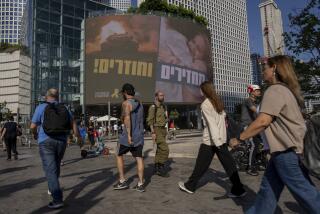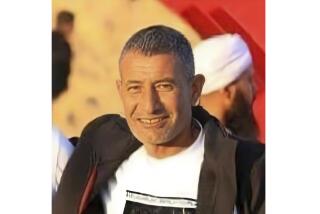One Life Saved Worth the Work for Israeli Team
CINARCIK, Turkey — When 11-year-old Elif was finally freed Friday from a tomb of brick and concrete, her delivery came at the hands of an elite team of Israeli rescuers: military men who specialize in destruction, veterans of natural disasters and bombings from Buenos Aires to Nairobi, Kenya.
For 18 hours, they used hammers, pocketknives and chisels to chip away little by little at the debris that encased the Turkish girl.
The Israeli squad had to free the child and keep her alive while not toppling tons of wrecked building onto their own hard-hatted heads.
In this, the Israelis are experts, skilled by years of battling terrorism. They were among the first and largest contingents in a veritable army of foreign rescue workers--including Americans, Britons and Greeks--that descended on Turkey within hours of Tuesday’s magnitude 7.4 earthquake.
But the destruction in Turkey is so widespread and overwhelming, and no amount of help can change the fact that tens of thousands of people might have been killed. And so rescuers such as the Israelis celebrate the small victories--a single life saved.
Elif, whose last name the Israelis never learned, was sleeping in her underwear when the quake flattened three seven-story apartment buildings in the complex where she lived. The complex is on the edge of this somewhat bucolic town of 31,000 that normally drapes gracefully over hills that roll toward the Sea of Marmara.
The Israeli team was brought to the site in part because nine Israeli citizens were among the missing and feared dead in the complex. The rescuers set to work excavating the mountains of pulverized concrete and mangled metal dotted with the details of loss: a plaid blanket, a red laundry basket, a white lacy curtain fluttering amid the chaos.
On Thursday afternoon, a Turkish rescuer heard Elif’s cries, and the Israelis were summoned to the spot.
A painstaking, agonizing operation began, team members said. With small hammers they widened an opening near the head of the prone girl, who lay wedged behind a beam and under a roof slab. She was barely alive, doctors said, dehydrated and weak. Yet she was able to speak calmly and lucidly, describing what hurt and telling them that she could not move one leg.
Capt. Nachum Nesher, a baby-faced doctor with the Israeli army, reached in, took her hand and began to intravenously give her saline, then a glucose solution. A probe attached to her finger monitored the oxygen level in her blood. One Israeli soldier was assigned to sit as close as possible to the girl, to maintain eye contact and keep her talking.
A nurse translated her words, and the soldiers taught her a little Hebrew. Nesher said she asked about her mother and father, who still had not been heard from late Friday.
The Israelis dug through the night, gently enlarging the opening. But Elif’s leg did not come free. Pressure was mounting on Nesher to amputate the limb.
“I resisted,” he recalled later, struggling to fight back tears. “She was so young and so beautiful.”
Finally, one of the smaller Israelis was lowered headfirst into the pit where Elif was trapped. He found what was pinning her leg.
A white Fiat.
Elif’s bedroom had fallen three stories and landed in the parking lot, and there she lay. About dawn Friday, the Israelis came up with a new plan. They dug a hole underneath Elif, then managed to rotate the car wheel so that the girl’s foot came free.
“It was a gamble,” said Maj. Amir Golan, who commanded the operation and described it in detail.
With a swift, firm tug, and as she cried as much in fear as in pain, Elif was yanked free. It ended an 18-hour rescue operation--and an 80-hour ordeal for Elif. The Israelis burst into applause and cheers as the dark-haired girl was whisked away to a field hospital.
“I feel like I did at the birth of my kids,” said Golan, a strapping 49-year-old who doesn’t appear to be given to sentimentality.
Golan and most of the other team members participated in rescue operations after a terrorist bombing at the U.S. Embassy in Nairobi last year that killed 213 people, and after a 1994 bombing of a Jewish community center in Buenos Aires that killed 86.
The Israelis say the impact of an earthquake is very different from that of a bombing. A bombing site is more self-contained, while an earthquake like the one that struck Turkey on Tuesday creates “disaster all around,” Maj. Offer Pomerantz said.
Moving from site to site, the Israelis see thousands of people camped outdoors, refusing to return to their homes for fear of further quakes. Basic services in most cities and towns in heavily damaged northwestern Turkey have broken down. And the cloying stench of death is everywhere.
People also have more of a chance to survive an earthquake than a bombing, the Israelis said, but the aftermath of a quake usually is more dangerous.
“In an explosion, the building blows up, then it goes down, and usually that’s it,” said Col. Udi Ben-Uri, top commander of the rescue teams. “With an earthquake, the building may still be moving.”
During a break in digging, Pomerantz, dressed in fatigues and tennis shoes, agreed: “I can’t work in an earthquake the way I can in a bombing, when I can go directly to where I think there will be survivors. With an earthquake, I have to make sure all the construction” is sound.
Like the Turks, members of the Israeli team are camping outside, a few yards from the hillside of rubble where they are working alongside a British fire brigade with sniffer dogs and dozens of Turkish volunteers.
By late Friday afternoon, the work had clearly begun to shift more toward removing debris than searching for survivors. A mammoth crane and three backhoes gnawed away while the sounds of jackhammers and power saws echoed through the valley.
At one of the collapsed buildings, Turks were doing their own digging, with no foreign crews to help. One man dug wearing dressy black pants and a vest. The bodies of four people could be seen protruding from the building’s accordion-like layers.
Seyithan Ergun, looking far older than his 50 years, said two of the bodies were his sons, ages 15 and 17. He wondered if someone would come help him pull them out.
More to Read
Sign up for Essential California
The most important California stories and recommendations in your inbox every morning.
You may occasionally receive promotional content from the Los Angeles Times.











